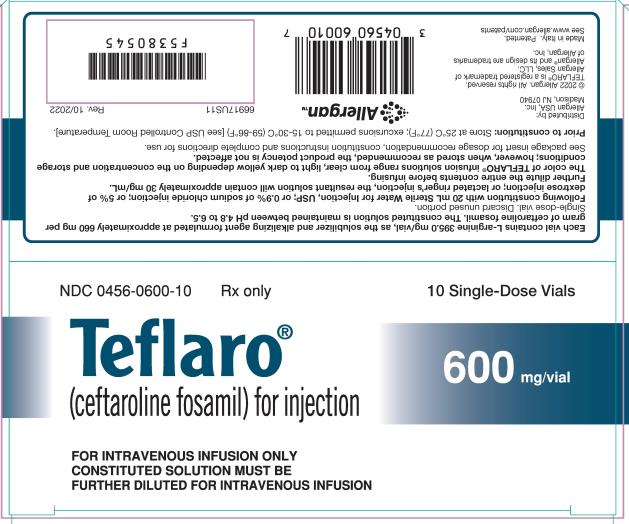Teflaro
Generic name: ceftaroline
Drug class: Next generation cephalosporins
Medically reviewed by A Ras MD.
What is Teflaro used for?
Teflaro is a prescription medicine that is used to treat bacterial infections.
Description
TEFLARO (ceftaroline fosamil) for injection, is a sterile, semi-synthetic, prodrug of the cephalosporin antibacterial class of beta-lactams (β-lactams) for intravenous use. Chemically, the prodrug, ceftaroline fosamil monoacetate monohydrate is (6R,7R)-7-{(2Z)-2-(ethoxyimino)-2-[5-(phosphonoamino)-1,2,4-thiadiazol-3-yl]acetamido}-3-{[4-(1-methylpyridin-1-ium-4-yl)-1,3-thiazol-2-yl]sulfanyl}-8-oxo-5-thia-1-azabicyclo[4.2.0]oct-2-ene-2-carboxylate monoacetate monohydrate. Its molecular weight is 762.75. The empirical formula is C22H21N8O8PS4.C2H4O2.H2O.

Teflaro vials contain either 600 mg or 400 mg of anhydrous ceftaroline fosamil (equivalent to 668 mg and 446 mg, respectively, of ceftaroline fosamil monoacetate monohydrate). The powder for injection is formulated from ceftaroline fosamil monoacetate monohydrate, a pale yellowish-white to light yellow sterile powder. Each vial of 400 mg of anhydrous ceftaroline fosamil includes inactive ingredient L-arginine 263.3 mg/vial as the solubilizer and alkalizing agent. Each vial of 600 mg of anhydrous ceftaroline fosamil includes inactive ingredient L-arginine 395.0 mg/vial as the solubilizer and alkalizing agent. All references to ceftaroline activity are expressed in terms of the prodrug, ceftaroline fosamil. The powder is constituted for IV injection [see Dosage and Administration (2.3)].
The pH of the constituted solution is pH 4.8 to 6.5.
Before taking Teflaro, tell your doctor:
- If you are allergic to Teflaro; any part of this medicine; or any other drugs, foods, or substances. Tell your doctor about the allergy and what signs you had.
This medicine may interact with other drugs or health problems.
Tell your doctor and pharmacist about all of your drugs (prescription or OTC, natural products, vitamins) and health problems. You must check to make sure that it is safe for you to take Teflaro with all of your drugs and health problems. Do not start, stop, or change the dose of any drug without checking with your doctor.
What are some things I need to know or do while I take Teflaro?
- Tell all of your health care providers that you take Teflaro. This includes your doctors, nurses, pharmacists, and dentists.
- This medicine may affect certain lab tests. Tell all of your health care providers and lab workers that you take Teflaro.
- Severe and sometimes deadly allergic side effects have rarely happened with drugs like this one.
- Do not use longer than you have been told. A second infection may happen.
- If you are 65 or older, use Teflaro with care. You could have more side effects.
- Tell your doctor if you are pregnant or plan on getting pregnant. You will need to talk about the benefits and risks of using Teflaro while you are pregnant.
- Tell your doctor if you are breast-feeding. You will need to talk about any risks to your baby.
How is Teflaro best taken?
Use Teflaro as ordered by your doctor. Read all information given to you. Follow all instructions closely.
- It is given as an infusion into a vein over a period of time.
What do I do if I miss a dose?
- Call your doctor to find out what to do.
What are the side effects of Teflaro that I need to call my doctor about immediately?
WARNING/CAUTION: Even though it may be rare, some people may have very bad and sometimes deadly side effects when taking a drug. Tell your doctor or get medical help right away if you have any of the following signs or symptoms that may be related to a very bad side effect:
- Signs of an allergic reaction, like rash; hives; itching; red, swollen, blistered, or peeling skin with or without fever; wheezing; tightness in the chest or throat; trouble breathing, swallowing, or talking; unusual hoarseness; or swelling of the mouth, face, lips, tongue, or throat.
- Diarrhea is common with antibiotics. Rarely, a severe form called C diff–associated diarrhea (CDAD) may happen. Sometimes, this has led to a deadly bowel problem (colitis). CDAD may happen during or a few months after taking antibiotics. Call your doctor right away if you have stomach pain, cramps, or very loose, watery, or bloody stools. Check with your doctor before treating diarrhea.
What are some other side effects of Teflaro?
All drugs may cause side effects. However, many people have no side effects or only have minor side effects. Call your doctor or get medical help if any of these side effects or any other side effects bother you or do not go away:
- Diarrhea.
- Upset stomach or throwing up.
These are not all of the side effects that may occur. If you have questions about side effects, call your doctor. Call your doctor for medical advice about side effects.
You may report side effects to the FDA at 1-800-332-1088. You may also report side effects at https://www.fda.gov/medwatch.
If overdose is suspected:
If you think there has been an overdose, call your poison control center or get medical care right away. Be ready to tell or show what was taken, how much, and when it happened.
How do I store and/or throw out Teflaro?
- If you need to store Teflaro at home, talk with your doctor, nurse, or pharmacist about how to store it.
Label
PRINCIPAL DISPLAY PANEL
NDC 0456-0400-10
Teflaro®
(ceftaroline fosamil) for injection
400 mg/vial
10 Single-Use Vials
Rx Only

PRINCIPAL DISPLAY PANEL
NDC 0456-0600-10
Teflaro®
(ceftaroline fosamil) for injection
600 mg/vial
10 Single-Use Vials
Rx Only

SRC: NLM .
